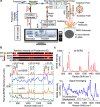Spread spectrum SERS allows label-free detection of attomolar neurotransmitters
- PMID: 33420035
- PMCID: PMC7794485
- DOI: 10.1038/s41467-020-20413-8
Spread spectrum SERS allows label-free detection of attomolar neurotransmitters
Abstract
The quantitative label-free detection of neurotransmitters provides critical clues in understanding neurological functions or disorders. However, the identification of neurotransmitters remains challenging for surface-enhanced Raman spectroscopy (SERS) due to the presence of noise. Here, we report spread spectrum SERS (ss-SERS) detection for the rapid quantification of neurotransmitters at the attomolar level by encoding excited light and decoding SERS signals with peak autocorrelation and near-zero cross-correlation. Compared to conventional SERS measurements, the experimental result of ss-SERS shows an exceptional improvement in the signal-to-noise ratio of more than three orders of magnitude, thus achieving a high temporal resolution of over one hundred times. The ss-SERS measurement further allows the attomolar SERS detection of dopamine, serotonin, acetylcholine, γ-aminobutyric acid, and glutamate without Raman reporters. This approach opens up opportunities not only for investigating the early diagnostics of neurological disorders or highly sensitive biomedical SERS applications but also for developing low-cost spectroscopic biosensing applications.
Conflict of interest statement
The authors declare no competing interests.
Figures




Similar articles
-
Multi-metal, Multi-wavelength Surface-Enhanced Raman Spectroscopy Detection of Neurotransmitters.ACS Chem Neurosci. 2018 Jun 20;9(6):1380-1387. doi: 10.1021/acschemneuro.8b00020. Epub 2018 Apr 5. ACS Chem Neurosci. 2018. PMID: 29601719
-
Self-Referenced Surface-Enhanced Raman Scattering Nanosubstrate for the Quantitative Detection of Neurotransmitters.ACS Appl Bio Mater. 2022 May 16;5(5):2403-2410. doi: 10.1021/acsabm.2c00272. Epub 2022 Apr 13. ACS Appl Bio Mater. 2022. PMID: 35417131
-
Surface-enhanced spatially-offset Raman spectroscopy (SESORS) for detection of neurochemicals through the skull at physiologically relevant concentrations.Analyst. 2020 Mar 7;145(5):1885-1893. doi: 10.1039/c9an01708a. Epub 2020 Jan 23. Analyst. 2020. PMID: 31971169
-
Label-free SERS in biological and biomedical applications: Recent progress, current challenges and opportunities.Spectrochim Acta A Mol Biomol Spectrosc. 2018 May 15;197:56-77. doi: 10.1016/j.saa.2018.01.063. Epub 2018 Jan 31. Spectrochim Acta A Mol Biomol Spectrosc. 2018. PMID: 29395932 Review.
-
In Vitro and In Vivo SERS Biosensing for Disease Diagnosis.Biosensors (Basel). 2018 May 11;8(2):46. doi: 10.3390/bios8020046. Biosensors (Basel). 2018. PMID: 29751641 Free PMC article. Review.
Cited by
-
Tunable Nanoislands Decorated Tapered Optical Fibers Reveal Concurrent Contributions in Through-Fiber SERS Detection.ACS Photonics. 2024 Aug 28;11(9):3774-3783. doi: 10.1021/acsphotonics.4c00912. eCollection 2024 Sep 18. ACS Photonics. 2024. PMID: 39310299 Free PMC article.
-
Challenges and Prospects of Personalized Healthcare Based on Surface-Enhanced Raman Spectroscopy.Research (Wash D C). 2024 Dec 27;7:0572. doi: 10.34133/research.0572. eCollection 2024. Research (Wash D C). 2024. PMID: 40771575 Free PMC article. Review.
-
Raman Spectroscopy on Brain Disorders: Transition from Fundamental Research to Clinical Applications.Biosensors (Basel). 2022 Dec 26;13(1):27. doi: 10.3390/bios13010027. Biosensors (Basel). 2022. PMID: 36671862 Free PMC article. Review.
-
Plasmonic Sensing Assay for Long-Term Monitoring (PSALM) of Neurotransmitters in Urine.ACS Nanosci Au. 2022 Dec 24;3(2):161-171. doi: 10.1021/acsnanoscienceau.2c00048. eCollection 2023 Apr 19. ACS Nanosci Au. 2022. PMID: 37096231 Free PMC article.
-
A GABAergic system in atrioventricular node pacemaker cells controls electrical conduction between the atria and ventricles.Cell Res. 2024 Aug;34(8):556-571. doi: 10.1038/s41422-024-00980-x. Epub 2024 Jun 7. Cell Res. 2024. PMID: 38849501 Free PMC article.
References
Publication types
MeSH terms
Substances
LinkOut - more resources
Full Text Sources
Other Literature Sources
Miscellaneous

